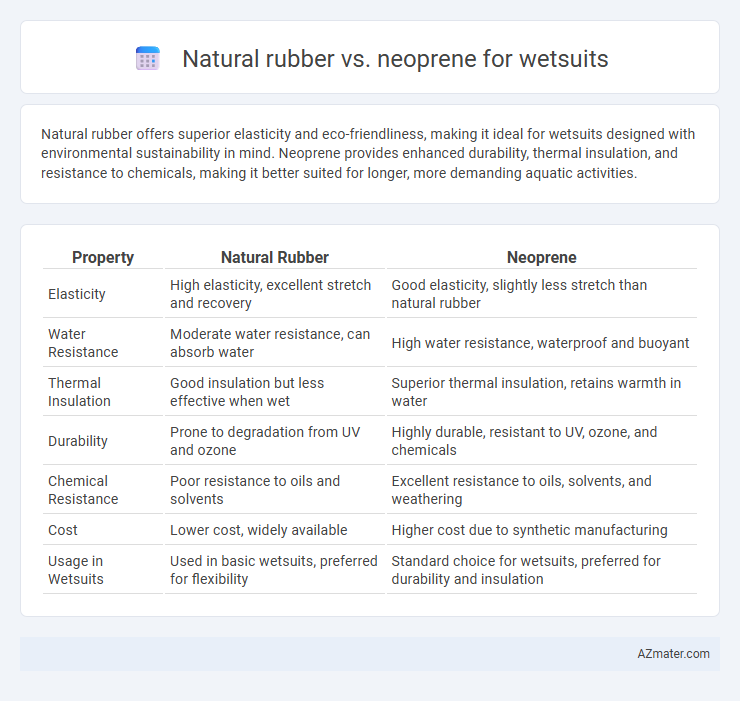Natural rubber offers superior elasticity and eco-friendliness, making it ideal for wetsuits designed with environmental sustainability in mind. Neoprene provides enhanced durability, thermal insulation, and resistance to chemicals, making it better suited for longer, more demanding aquatic activities.
Table of Comparison
| Property | Natural Rubber | Neoprene |
|---|---|---|
| Elasticity | High elasticity, excellent stretch and recovery | Good elasticity, slightly less stretch than natural rubber |
| Water Resistance | Moderate water resistance, can absorb water | High water resistance, waterproof and buoyant |
| Thermal Insulation | Good insulation but less effective when wet | Superior thermal insulation, retains warmth in water |
| Durability | Prone to degradation from UV and ozone | Highly durable, resistant to UV, ozone, and chemicals |
| Chemical Resistance | Poor resistance to oils and solvents | Excellent resistance to oils, solvents, and weathering |
| Cost | Lower cost, widely available | Higher cost due to synthetic manufacturing |
| Usage in Wetsuits | Used in basic wetsuits, preferred for flexibility | Standard choice for wetsuits, preferred for durability and insulation |
Introduction to Wetsuit Materials
Natural rubber and neoprene are the primary materials used in wetsuit manufacturing, each offering distinct properties for thermal insulation and flexibility. Natural rubber is biodegradable and provides excellent elasticity but has limited resistance to oils and UV exposure compared to neoprene. Neoprene, a synthetic rubber, offers superior durability, water resistance, and consistent insulation performance, making it the preferred choice for modern wetsuits in diverse water sports.
Overview of Natural Rubber
Natural rubber, derived from the latex of Hevea brasiliensis trees, offers exceptional elasticity and superior flexibility, making it a prime material for wetsuit construction. Its biodegradable and renewable nature positions it as an environmentally friendly alternative to synthetic neoprene, which is petroleum-based and less sustainable. Despite being less resistant to oils and UV exposure than neoprene, natural rubber wetsuits provide excellent thermal insulation and comfort for divers and surfers in moderate water temperatures.
Understanding Neoprene
Neoprene, a synthetic rubber, offers superior insulation and flexibility compared to natural rubber, making it the preferred material for wetsuits. Its closed-cell structure provides excellent buoyancy and water resistance, enhancing thermal protection in cold water environments. Unlike natural rubber, neoprene maintains its properties over extended use without degrading from exposure to saltwater, UV rays, or oils.
Environmental Impact: Natural Rubber vs Neoprene
Natural rubber wetsuits offer a significant environmental advantage due to their biodegradability and renewable sourcing from rubber trees, reducing reliance on fossil fuels. Neoprene production involves petrochemicals, resulting in higher carbon emissions and persistent waste in landfills due to its non-biodegradable nature. Choosing natural rubber helps minimize ecological footprints associated with wetsuit manufacturing and end-of-life disposal.
Flexibility and Comfort Comparison
Natural rubber wetsuits offer superior elasticity and softness, providing exceptional flexibility and a close, comfortable fit ideal for prolonged water activities. Neoprene wetsuits, while slightly less flexible than natural rubber, excel in durability and thermal insulation but may feel stiffer and less conforming to body movements. The choice between natural rubber and neoprene directly impacts the wetsuit's comfort level and range of motion, with natural rubber favored for enhanced flexibility.
Thermal Insulation Performance
Natural rubber wetsuits exhibit excellent thermal insulation due to their dense cellular structure, effectively trapping body heat in cold water. Neoprene wetsuits, widely used for their consistent thermal resistance, provide superior insulation with added flexibility and durability in various water temperatures. The closed-cell foam in neoprene minimizes water absorption, enhancing warmth and comfort compared to natural rubber, which may degrade faster when exposed to UV and chemicals.
Durability and Longevity
Natural rubber wetsuits offer excellent flexibility but tend to degrade faster due to UV exposure and saltwater, reducing overall durability and longevity. Neoprene wetsuits provide superior resistance to abrasion, chemicals, and thermal degradation, resulting in enhanced durability and a longer lifespan. Investing in neoprene ensures sustained performance and durability for extended wetsuit use in diverse environments.
Allergy Risks and Skin Sensitivity
Natural rubber wetsuits pose a higher allergy risk due to latex proteins triggering allergic reactions in sensitive individuals, leading to itching, redness, or rash. Neoprene wetsuits, made from synthetic rubber, are hypoallergenic and less likely to cause skin irritation, making them suitable for people with latex sensitivity. Choosing neoprene minimizes the chance of contact dermatitis and allergic responses during prolonged water exposure.
Price and Accessibility
Natural rubber wetsuits generally offer lower prices due to their abundant raw material availability and simpler manufacturing processes, making them more accessible to budget-conscious consumers. Neoprene wetsuits tend to be more expensive because of synthetic production and superior durability properties, which increase manufacturing costs. Despite higher prices, neoprene's widespread availability in various thicknesses and styles ensures broad accessibility for performance-focused divers and surfers.
Which Material is Best for Your Needs?
Natural rubber offers superior flexibility, breathability, and eco-friendliness, making it ideal for wetsuits in warm to moderate water conditions and for users prioritizing sustainability. Neoprene provides excellent thermal insulation, durability, and chemical resistance, better suited for colder water and high-impact activities. Choosing between natural rubber and neoprene depends on water temperature, durability requirements, and environmental considerations specific to your wetsuit needs.

Infographic: Natural rubber vs Neoprene for Wet suit
 azmater.com
azmater.com